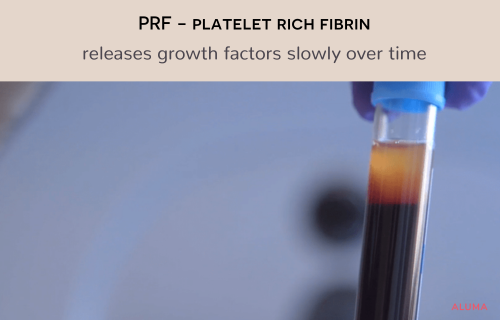Every week, we see new skin trends pop up on social. It’s a lot to sort through. At Aluma, we’re about helping you make informed, confident choices. So let’s take a moment to examine the science and which options are worth your time and investment.
Will Red Light Therapy Increase Collagen Production
Red light therapy (RLT) has been touted for its ability to reduce fine lines, calm inflammation, clear acne, and even improve skin texture. It’s no surprise that at-home LED masks are showing up everywhere. But how effective is red light therapy?
Scientifically speaking, RLT works by delivering low-wavelength red light to the skin, which is thought to stimulate the mitochondria—the energy centers of your cells. They are responsible for the migration of cells during wound healing, the creation of melanin, and contribute to the hair follicle’s growth cycle. Scientists theorize that with increased cell energy, skin cells may function more efficiently, leading to enhanced collagen production and increased cell turnover, which is a win for the skin.
Early studies and anecdotal reports are encouraging, but the reality is that most research on red light therapy is still in its infancy. Many of the existing studies are small, lack control groups, or are based on lab models rather than real-world use. More placebo-controlled human trials are needed for red light therapy to be considered a proven anti-aging skin treatment.
In addition to lacking evidence, it’s also important to note that not all red light therapy devices are created equal. Medical-grade red light therapy devices typically cost $2,000–$6,000 and are used in professional settings. Thus, most consumer-grade LED masks, which often range in price from $150 to $400, do not emit strong enough wavelengths or maintain them long enough to achieve adequate stimulation of the mitochondria. Worse yet, improper use of low-quality or non-FDA-cleared devices can actually do more harm than good. Potential side effects include increased redness and hyperpigmentation.
Is Beef Tallow Good for Skin
Beef tallow—a rendered fat from cows—is also having its moment in skincare, particularly among fans of natural, DIY routines. Beef tallow is said to lock in moisture, soothe irritated skin, and support a compromised skin barrier. Rich in essential fatty acids, anti-inflammatory compounds, and fat-soluble vitamins, it may help with dryness, redness, and even conditions like eczema when used sparingly, thanks to its composition, which closely resembles the skin’s natural oils
However, this remedy isn’t for all skin types. Dermatologists warn that beef tallow is highly comedogenic, meaning it can clog pores and trigger breakouts, especially for those with acne-prone or oily skin types. It also contains high levels of oleic acid, which can disrupt the skin barrier in people with sensitive skin, leading to increased moisture loss, dryness, and sensitivity to sunlight.
While beef tallow may provide temporary relief for dry, irritated skin, it is not a science-backed solution for stimulating collagen, supporting facial structures affected by aging, or delivering long-term regenerative anti-aging benefits.
Will Gua Sha Reduce Wrinkles
Rooted in traditional Chinese medicine, gua sha involves gently scraping the skin with a smooth-edged tool to improve circulation and release tension. Practitioners believe this technique helps clear stagnant “chi,” or energy, thought to contribute to inflammation and disease.
Today, it’s most often used on the face as a skincare ritual—and yes, it can absolutely feel amazing. Gua sha may temporarily increase blood flow to the face and help relax tight facial muscles, which can soften the appearance of tension lines, such as the “11’s.” However, this is mainly a short-term effect, as massaging temporarily relaxes the muscle. Gua sha is often praised for reducing under-eye puffiness and giving the face a lifted appearance. Still, these effects are typically subtle and temporary, stemming from increased circulation and lymphatic drainage rather than any structural change to the skin.
Despite its spa-like appeal, the evidence supporting gua sha’s more dramatic skin claims—such as erasing wrinkles, defining the jawline, or tightening skin—is limited. It doesn’t stimulate collagen like microneedling or Sculptra. It cannot add volume to sunken areas like dermal fillers, nor will it reduce moderate to severe wrinkles like Botox or Dysport. We think it’s a great addition to your self-care routine, but not a substitute for prescription aesthetic injectables that offer noticeable, long-lasting results.
Exosomes versus PRF – what is better
/In the growing world of regenerative aesthetics, two buzzworthy compounds—exosomes and PRF (platelet-rich fibrin)—are often compared as go-to tools for skin rejuvenation. Both are praised for stimulating healing, improving skin texture, and enhancing glow. But if you’re wondering which one is fresher, less processed, and potentially more potent, it all comes down to where they come from—and how they’re made.
PRF comes directly from you. It’s made by drawing a small sample of your blood, spinning it in a centrifuge at a low speed (unlike PRP, which uses higher speeds), and collecting the fibrin matrix rich in platelets, white blood cells, and growth factors. Because it’s 100% autologous—meaning it’s your own biological material—it’s the freshest and most natural option available. Nothing is added, and nothing is removed. There’s no risk of allergic reaction or rejection, and you know exactly what’s going into your skin. PRF also releases growth factors slowly over time, which can lead to longer-lasting benefits with minimal processing or manipulation.

Exosomes, on the other hand, are not derived from your own body. These tiny extracellular vesicles are harvested from cultured stem cells—most commonly from human umbilical cord-derived mesenchymal stem cells. Exosomes require multiple steps for extraction and purification. Techniques like ultracentrifugation, ultrafiltration, and immunoaffinity are used to isolate exosomes from other cellular debris. This process is far more complex than a simple blood draw and introduces variability in purity and potency across different manufacturers. Even when done well, the final product is still a lab-processed, donor-derived material, not a fresh, personalized treatment like PRF.
So, which is more potent? That depends on how you define potency. Exosomes carry a dense package of signaling molecules like RNA, proteins, and growth factors that may offer a more concentrated regenerative signal, but that’s still largely theoretical. PRF has been used since the early 2000’s, while less novel, is proven, personal, and designed by your own biology to work with your body. It’s hard to get more biocompatible than that.
In Conclusion
Skincare trends will always come and go—one month it’s gua sha, the next it’s exosomes, and before long, something new will take over your feed. While some of these innovations offer real benefits, many deliver only temporary results or lack the research to support their bold claims. If your goal is long-lasting, noticeable improvement, the smartest approach is to invest in proven, evidence-backed treatments—like collagen-stimulating injectables, neuromodulators, or PRF—administered by a skilled injector. The right provider isn’t just someone who follows trends, but someone with deep anatomical knowledge and extensive hands-on experience. When artistry meets science, that’s where you’ll see truly transformative, safe, and lasting results.
Interested in learning what aesthetic treatments are best for you? Book a consultation at Aluma Aesthetic Medicine.

